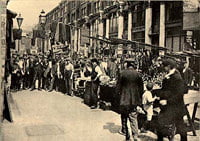Guided Tour of London’s Jewish East End
From Aldgate East Tube Station
By The Jewish Museum
Guide Dennis Davis
Once Upon a time In The East End
In a city of a multitude of cultures, there is a corner whose extraordinary Jewish history is made more poignant by being invisible. London’s buildings, streets and area names are steeped in the past going back to Roman times, so one might wonder, given that the Jewish presence in the country recently celebrated its 350th anniversary, why there is so little evidence of this presence in the part of London where it was once so thriving, the East End. Now the vibrant Jewish past, saturated with human experience, is a neglected garden, overgrown with evidence of the present occupiers, aided and abetted by Hitler’s Luftwaffe.

Last Sunday I went on a walking tour of the ‘Jewish’ East End of London, arranged by the Jewish Museum in Camden, soon to be re-invented. Thinking that there might be something enriching to see, I was continually bereft of any visual emotion. Where there was once a bustling Hessel street market, redolent of a thousand foods, now there is just a street. Where the sweatshops, manned by the immigrant refugees from second world war atrocities, gave meagre livelihoods to thousands, now there are anonymous commercial buildings. Where the Grand Palais of Yiddish Theatre once flourished, now Flick Fashions presides.
At various times Trotsky, Gorky, Rosa Luxembourg and even Stalin could be seen at conferences. Roughton House, the sixpence-a-night residence for working men, where Lenin stayed on his visits to London, lives merely in the passing reference of a tour guide.
In the Jewish East End of London there are not enough Jews to produce a quorum for a religious service. The remaining synagogues are relics, with no barmitzvahs, no weddings, and no Hebrew schools to keep them open. There are no kosher bakeries, no Jewish delicatessens and few Jewish residents. What was not flattened by war time bombs has been replaced by commercial realities. The odd Victorian brick building is shouldered aside by matchbox modern structures, and there is little worth looking at anymore.
Other cultures rule now. Alongside huge apartment blocks named for the Muslim community, a huge mosque now stands proud where once the Jewish community lived, worked and prayed. There is even a healthy German Catholic presence.
When Oswald Mosley led 2000 of his Black Shirts on a march through the Jewish streets escorted by 6000 police, the Nazi thugs were thwarted by the barricades manned by Jews alongside Irish and Cockney dockworkers, alienated not persuaded by the fascist message. Now the barricades of the Battle of Cable Street are a distant memory. Only the name of the street remains of the story for those who want to listen.
The Jews have emigrated to other parts and taken their culture with them. With the economic mobility that the generations developed there is no need to come back to this cold, forsaken remnant. The disappearance from the area of a chapter in the story of Jewish survival is not entirely bitter, however. The loss is sweetened by the move away having been of the Jews’ own volition, not decided or ‘assisted’ by anyone else on this occasion.
Recommended
Saul Reichlin
London Correspondent
Call: +44 (0) 020 8371 7373 Tickets £10, Email: [email protected], Periodic Sundays 10.15 am, 9 Aldgate High Street, EC3N 1AH, Running time 2 hour 30 mins with no intermission.
